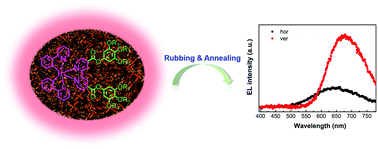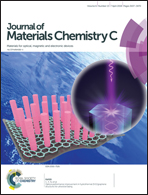Linearly polarized electroluminescence from ionic iridium complex-based metallomesogens: the effect of aliphatic-chain on their photophysical properties†
Abstract
Directly polarized organic light emitting diodes (OLEDs) have the potential to significantly improve the efficiency and reduce the cost of liquid-crystal displays (LCDs) among other applications. However, fluorescent liquid crystals are currently used to achieve this, while phosphorescent emitters would further improve efficiency. To this end, the metallomesogens based on ionic iridium complexes bearing different aliphatic chains substituent, named 7a and 7b, were designed and prepared in this contribution. Both iridium complexes showed smectic mesophase evidenced by differential scanning calorimetry, polarized optical microscopy and X-ray diffraction. Deep-red emission was observed for the iridium complexes in solution and solid state, and complex 7a clearly presented aggregation-induced emission (AIE) behavior in THF–water solvent mixture. Non-doped polarized OLEDs employing complex 7a or 7b as emitter were fabricated and direct linearly polarized electroluminescence with a polarization ratio of 4 was achieved, which is the highest ratio reported for metallomesogens-based phosphorescent OLEDs. Importantly, the choice of linker between the core complex and mesogenic pendent groups is key to achieve distinctive polarization of electroluminescence and AIE. These results are a first step towards the development phosphorescent OLEDs able to efficiently produce polarized electroluminescence.



 Please wait while we load your content...
Please wait while we load your content...